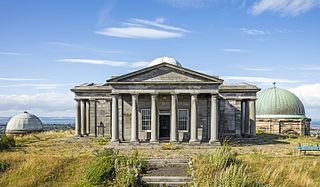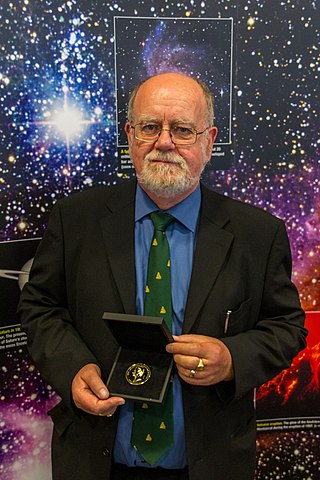
Airdrie is a town in North Lanarkshire, Scotland. It lies on a plateau roughly 400 ft above sea level, and is approximately 12 miles (19 km) east of Glasgow city centre. As of 2012, the town had a population of around 37,130. Historically part of Lanarkshire, Airdrie forms part of a conurbation with its neighbour Coatbridge, in what is commonly known as the Monklands, formerly a district..

North Lanarkshire is one of the 32 council areas of Scotland. It borders the north-east of the Glasgow City council area and contains many of Glasgow's suburbs, commuter towns, and villages. It also borders East Dunbartonshire, Falkirk, Stirling, South Lanarkshire, and West Lothian. The council area covers parts of the historic counties of Dunbartonshire, Lanarkshire, and Stirlingshire. The council is based in Motherwell.

Lanarkshire, also called the County of Lanark, is a historic county, lieutenancy area and registration county in the Central Lowlands of Scotland. The county is no longer used for local government purposes, but gives its name to the two modern council areas of North Lanarkshire and South Lanarkshire.

A waverider is a hypersonic aircraft design that improves its supersonic lift-to-drag ratio by using the shock waves being generated by its own flight as a lifting surface, a phenomenon known as compression lift.

Steven Alan Hawley is a former NASA astronaut who flew on five U.S. Space Shuttle flights. He is professor of physics and astronomy and director of engineering physics at the University of Kansas.

The City Observatory was an astronomical observatory on Calton Hill in Edinburgh, Scotland. It is also known as the Calton Hill Observatory.

John Campbell Brown was a Scottish astronomer who worked primarily in solar physics. He held the posts of Astronomer Royal for Scotland, the Regius Professor of Astronomy at the University of Glasgow, and honorary professorships at both the University of Edinburgh and the University of Aberdeen.

The Royal Observatory, Edinburgh (ROE) is an astronomical institution located on Blackford Hill in Edinburgh. The site is owned by the Science and Technology Facilities Council (STFC). The ROE comprises the UK Astronomy Technology Centre (UK ATC) of STFC, the Institute for Astronomy of the School of Physics and Astronomy of the University of Edinburgh, and the ROE Visitor Centre.
Cambuslang Football Club was a Scottish football club, based in the Cambuslang area. Cambuslang was one of the founding members of the Scottish Football League, but left the league after just two seasons.

Airdrie Public Observatory is a fully operational, historic astronomical observatory, which is part of the library building in the town of Airdrie, North Lanarkshire, Scotland. There are only four public observatories operating in the United Kingdom, all of which are in Scotland. Airdrie Observatory is the smallest, and second oldest.

Mills Observatory is the first purpose-built public astronomical observatory in the UK, located in Dundee, Scotland. Built in 1935, the observatory is classically styled in sandstone and has a distinctive 7 m dome, which houses a Victorian refracting telescope, a small planetarium, and display areas. The dome is one of two made from papier-mâché to survive in the UK, the other being at the Godlee Observatory.

Coats Observatory is Scotland's oldest public observatory. It is currently closed for refurbishment as part of a 4-year long £42m transformation of the observatory and museum buildings. Located in Oakshaw Street West, Paisley, Renfrewshire, the observatory has been operational since 1 October 1883 and continues to function to this day, offering visitors the opportunity to view the night sky through the powerful telescopes housed within the building. The observatory is currently closed for redevelopment and is due to reopen in 2023.
Airdrie Public Library is a public library in Airdrie, North Lanarkshire, Scotland. The library has been housed in a number of buildings since its founding.
Sir James Hough is a British physicist and an international leader in the search for gravitational waves.

Duncan Alasdair Lunan, born October 1945, is a Scottish author with emphasis on astronomy, spaceflight and science fiction, undertaking a wide range of writing and speaking on those and other topics as a researcher, tutor, critic, editor, lecturer and broadcaster. He is known for his science writings as well as for his work on the Sighthill stone circle.
Terence Nonweiler held a Chair of Aeronautical Engineering at Glasgow University and later became Dean of the Faculty of Engineering. He has been credited with being the pioneer of wave-riding technology.

The Astronomical Society of Glasgow (ASG) was founded in 1954 in Glasgow, Scotland, by amateur astronomers and is dedicated to promoting an interest in Astronomy.
Jane MacArthur FRAS is a British planetary scientist and science writer based in Leicester.
Lyndsay Fletcher is a Scottish astrophysicist at the University of Glasgow who specialises in solar flares.

The Astronomical Society of Edinburgh (ASE) is an association of amateur astronomers and other individuals interested in astronomy, which is based in Edinburgh, Scotland. The objectives are to encourage astronomical study and observation and to increase popular interest in astronomy.














